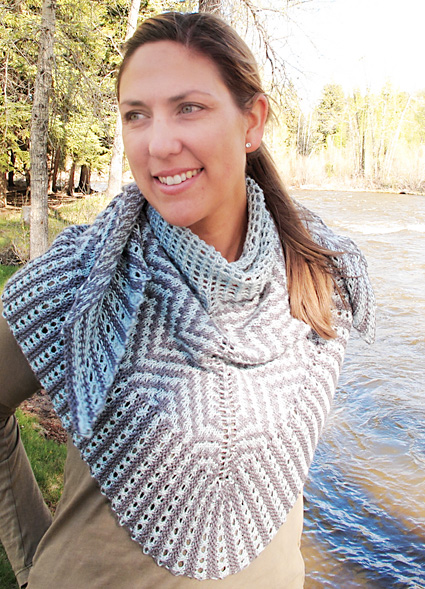

|
|
|

My visit to Cambridge last spring began with a walk across a small bridge over the River Cam. During the following days, as I wandered the walks, alleys and lanes of the colleges touring the buildings and gardens, I learned that this small bridge is popularly known as the Mathematical Bridge, a reference to its lines and angles. Though it may be small, the bridge is a wonder of construction that feeds the prevalent folklore of Cambridge. Rumors hold that is put together without bolts or screws, that it was once taken apart and reassembled by prankster students, and that its design references Newton’s mathematical principles. Though I wasn’t taken in
by its stories, the bridge enchanted me. As I worked
through the design for this shawl, I chose patterns
containing similar lines and angles. |
||
|
|

|
Tweet
|
|
SIZE |
|
|
FINISHED MEASUREMENTS |
|
MATERIALS Notions |
|
GAUGE |
16 sts/24 rows = 4 inches
in eyelet pattern with larger needle |
|
PATTERN NOTES |
|
M1L: Insert left needle, from front to back,
under strand of yarn which runs between last stitch on left
needle and first stitch on right needle; knit this stitch through
back loop. 1 stitch increased. |
Slip
stitch pattern • Transition
pattern Both charts revised Nov 12, '11 |
|
DIRECTIONS Begin Eyelet Pattern; Begin Reverse Eyelet Pattern: The next two rows add 23 sts to each side (in addition to the 4 shaping increases) to compensate for the smaller gauge of the sl st pattern. Row 1 [RS]: With CC, k1, yo, k1, [sl1 wyib, M1L,
k1] to marker, yo, slip marker, k1, yo, [k1, M1R, sl1 wyib]
to 2 sts before end, k1, yo, k1. 147 sts. Note: The slip stitch pattern only requires you work with 1 color at a time across a pair of rows – the stitches of the other color are slipped. The working color changes every 2 rows. You may find it helpful to use markers to divide up the 24 sts of the repeat. Row 1 [RS]: Work Slip Stitch Pattern Right Side Row
1 to marker, work Slip Stitch Pattern
Left Side Row 1 to end of row. Work another 7 repeats of the Charts. 96 sts increased on each side. 339 sts total; 2 edge sts, 1 center st, 167 sts each side. Transition to Border Work as set to end of Row 6 of chart. Break MC. After Row 8, work to end of row, using CC and backwards loop
method, cast on 16 sts. Change to smaller needle for working. Shawl stitches remain on larger needle. Note: Color in border should line up with color in Chart C. The last st of an odd-numbered border row is worked together with same color st of shawl edge as an ssk to join the border to the shawl as it is knitted. Begin the first repeat with Row 3. On this row of the first repeat, the ssk is worked over 2 sts of the shawl border. In subsequent rows and repeats, the ssk is worked over 1 st of the border and 1 st of the shawl. Reattach MC at start of row 5 of first repeat. Carry the color not in use along the edge of the border by twisting the colors at the beginning of all odd-numbered rows. Edging PatternRow 1 [RS]: With CC, k16, ssk last st with next shawl st. Row 2 [WS]: With CC, k. Rows 3 and 4, repeat Rows 1 and 2. Row 5 [RS]: With MC, k16, ssk last st with next shawl st. Row 6 [WS] With MC, sl 1, p16. Row 7 [RS]: With MC, [yo, ssk] 8 times, ssk last st with next shawl st. Row 8 [WS]: With MC, p. Repeat 8-row Edging Pattern to 1 st before marker. Turn the corner: You have completed the center turn of the border, 20 rows total. Work Rows 5-8 of Edging Pattern, then continue, repeating Rows 1-8 across until 2 sts rem in shawl, ending with Row 4. 18 sts rem, 16 on border, 2 on shawl. BO as follows: BO normally across first 15 sts, work ssk last border st with next shawl st, lift first st on right needle over this stitch to BO, and finish BO as normal. |
|
FINISHING |
| ABOUT THE DESIGNER |
|
After 25 years wrestling computers and other opponents, Susan Luni
retired 15 years too early and lost her
mind. A year later,
she found it under an unfinished afghan. While finishing
the afghan, she typed “yarn” in a search box and found
forums about crochet, blogs about knitting
and a whole new purpose for her computer. |
|
Pattern & images © 2011 Susan Luni. Contact Susan |